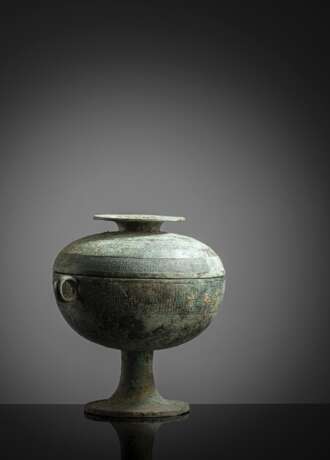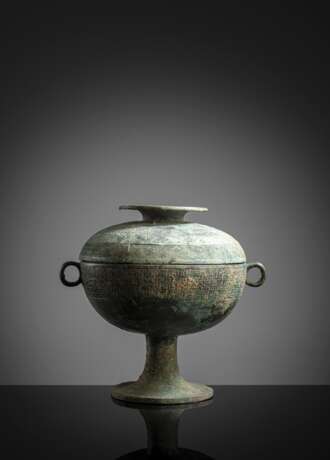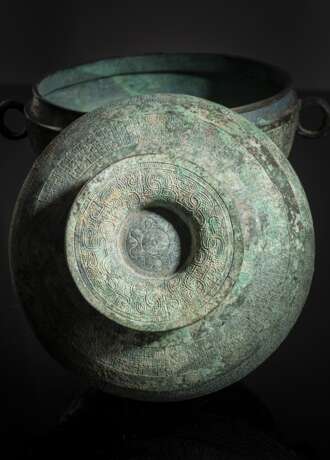ID 1215535
Lot 133 | Bronzegefäß 'dou'
Estimate value
€ 1 500 – 2 500
H. 20,5 cm
Die Schale steht auf einem hohen Fup, der Korpus ist mit stilisierten Motiven unter Bändern aus dicht angeordneten S-Rollen besetzt, die Seiten sind mit einem Paar Schlaufenhenkeln versehen, das gleiche Muster wiederholt sich auf dem Deckel, der den mit Flechtmustern verzierten, umgedrehten Abschluss umgibt, blassgrüne Patina mit Malachitverkrustungen.
Aus einer fränkischen Privatsammlung, zusammengetragen zwischen 1970 und 1995
Das vorliegende Gefäß ist ein schönes Beispiel für Getreidegefäße, die in der Östlichen Zhou-Periode (771-256 v. Chr.) bei rituellen Darbietungen zur Verehrung der Ahnen verwendet wurden. Es ist in Flachrelief gegossen und weist verschlungene Muster aus sich wiederholenden winzigen Einheiten auf, die jeweils aus einem diagonalen Geflecht mit C-Motiven in den oberen linken und rechten Ecken bestehen.
Der Ursprung des Dou lässt sich auf die flache Tazza der Longshan-Kultur in der späten Jungsteinzeit zurückverfolgen. Die Form war während der Shang- und Zhou-Dynastien weiterhin gebräuchlich. In der westlichen Zhou-Periode versuchte man, die einfache Keramikform zu verschönern, indem man sie aus Lack über einem Holzkern herstellte oder sie in Bronze goss.
Bronzeversionen des Dou-Gefäßes, wie das vorliegende Exemplar, dessen Standardform flache Schalen mit geraden vertikalen Seiten sind, die auf hohen Sockelfüßen stehen, entwickelten sich wahrscheinlich in der westlichen Zhou-Periode (1047-772 v. Chr.). Archäologische Ausgrabungen deuten darauf hin, dass die weitere Verfeinerung des gewölbten Deckels und der Laschengriffe zu Beginn der Östlichen Zhou-Periode hinzukam. Während der Östlichen Zhou-Dynastie ersetzten die dou-Gefäße allmählich ihr gui-Gegenstück und wurden zu den wichtigsten Getreidebehältern in einem rituellen Gefäßsatz; siehe J. So, Eastern Zhou Ritual Bronzes in the Arthur M. Sackler Collections, London, 1996, S. 179-180. Vergleichen Sie die Form und die feine Dekoration und deren Anordnung auf dem vorliegenden Gefäß mit einem verwandten Bronze-Dou, späte Frühlings- und Herbstperiode, 6. Jahrhundert v. Chr., abgebildet bei J. So, Eastern Zhou Ritual Bronzes in the Arthur M. Sackler Collections, London, 1996, Nr. 24. Ein ähnliches rituelles Speisegefäß aus Bronze mit Deckel, dou, 6. Jh. v. Chr., wurde am 19. September 2013 bei Christie's New York verkauft, Los 1108 - Der Stand ist teilweise restauriert, grüne Korrosion
| Address of auction |
Nagel Auktionen GmbH Neckarstrasse 189 - 191 70190 Stuttgart Germany | ||||||||||||||
|---|---|---|---|---|---|---|---|---|---|---|---|---|---|---|---|
| Preview | |||||||||||||||
| Phone | +49 (0)711 649 690 | ||||||||||||||
| Fax | +49 (0)711 649 69696 | ||||||||||||||
| Buyer Premium | 29,5% | ||||||||||||||
| Conditions of purchase | Conditions of purchase | ||||||||||||||
| Business hours | Business hours
|





